Hyunjin Hwang
Emergence of psychopathological computations in large language models
Apr 10, 2025Abstract:Can large language models (LLMs) implement computations of psychopathology? An effective approach to the question hinges on addressing two factors. First, for conceptual validity, we require a general and computational account of psychopathology that is applicable to computational entities without biological embodiment or subjective experience. Second, mechanisms underlying LLM behaviors need to be studied for better methodological validity. Thus, we establish a computational-theoretical framework to provide an account of psychopathology applicable to LLMs. To ground the theory for empirical analysis, we also propose a novel mechanistic interpretability method alongside a tailored empirical analytic framework. Based on the frameworks, we conduct experiments demonstrating three key claims: first, that distinct dysfunctional and problematic representational states are implemented in LLMs; second, that their activations can spread and self-sustain to trap LLMs; and third, that dynamic, cyclic structural causal models encoded in the LLMs underpin these patterns. In concert, the empirical results corroborate our hypothesis that network-theoretic computations of psychopathology have already emerged in LLMs. This suggests that certain LLM behaviors mirroring psychopathology may not be a superficial mimicry but a feature of their internal processing. Thus, our work alludes to the possibility of AI systems with psychopathological behaviors in the near future.
On Measuring Unnoticeability of Graph Adversarial Attacks: Observations, New Measure, and Applications
Jan 09, 2025



Abstract:Adversarial attacks are allegedly unnoticeable. Prior studies have designed attack noticeability measures on graphs, primarily using statistical tests to compare the topology of original and (possibly) attacked graphs. However, we observe two critical limitations in the existing measures. First, because the measures rely on simple rules, attackers can readily enhance their attacks to bypass them, reducing their attack "noticeability" and, yet, maintaining their attack performance. Second, because the measures naively leverage global statistics, such as degree distributions, they may entirely overlook attacks until severe perturbations occur, letting the attacks be almost "totally unnoticeable." To address the limitations, we introduce HideNSeek, a learnable measure for graph attack noticeability. First, to mitigate the bypass problem, HideNSeek learns to distinguish the original and (potential) attack edges using a learnable edge scorer (LEO), which scores each edge on its likelihood of being an attack. Second, to mitigate the overlooking problem, HideNSeek conducts imbalance-aware aggregation of all the edge scores to obtain the final noticeability score. Using six real-world graphs, we empirically demonstrate that HideNSeek effectively alleviates the observed limitations, and LEO (i.e., our learnable edge scorer) outperforms eleven competitors in distinguishing attack edges under five different attack methods. For an additional application, we show that LEO boost the performance of robust GNNs by removing attack-like edges.
AHP: Learning to Negative Sample for Hyperedge Prediction
Apr 15, 2022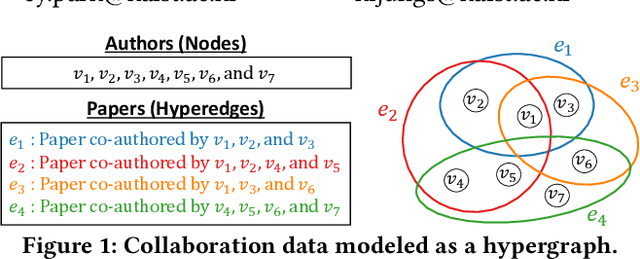
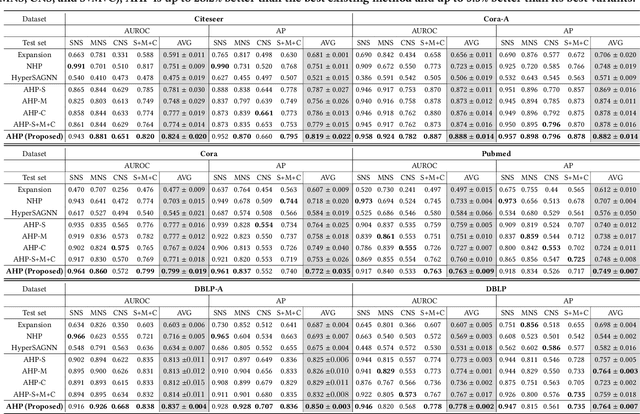
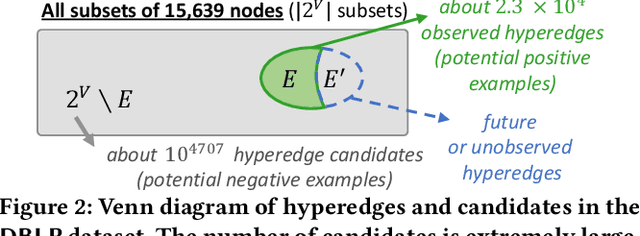
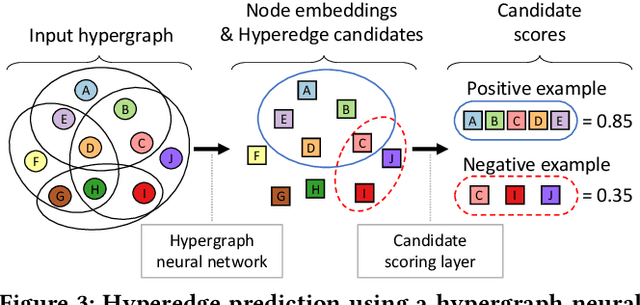
Abstract:Hypergraphs (i.e., sets of hyperedges) naturally represent group relations (e.g., researchers co-authoring a paper and ingredients used together in a recipe), each of which corresponds to a hyperedge (i.e., a subset of nodes). Predicting future or missing hyperedges bears significant implications for many applications (e.g., collaboration and recipe recommendation). What makes hyperedge prediction particularly challenging is the vast number of non-hyperedge subsets, which grows exponentially with the number of nodes. Since it is prohibitive to use all of them as negative examples for model training, it is inevitable to sample a very small portion of them, and to this end, heuristic sampling schemes have been employed. However, trained models suffer from poor generalization capability for examples of different natures. In this paper, we propose AHP, an adversarial training-based hyperedge-prediction method. It learns to sample negative examples without relying on any heuristic schemes. Using six real hypergraphs, we show that AHP generalizes better to negative examples of various natures. It yields up to 28.2% higher AUROC than the best existing methods and often even outperforms its variants with sampling schemes tailored to test sets.
Effective Training Strategies for Deep-learning-based Precipitation Nowcasting and Estimation
Feb 17, 2022
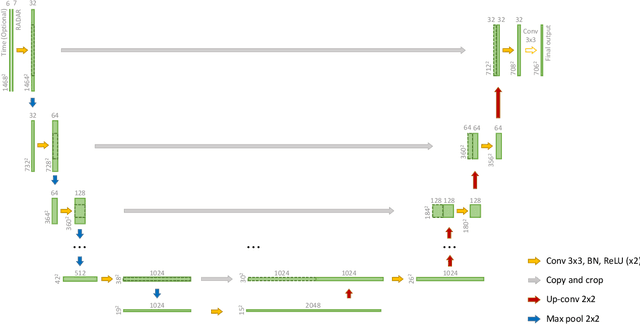
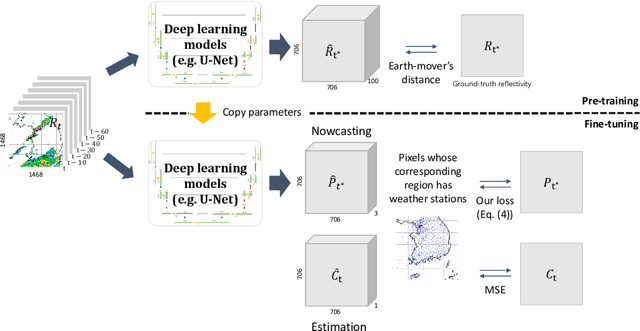

Abstract:Deep learning has been successfully applied to precipitation nowcasting. In this work, we propose a pre-training scheme and a new loss function for improving deep-learning-based nowcasting. First, we adapt U-Net, a widely-used deep-learning model, for the two problems of interest here: precipitation nowcasting and precipitation estimation from radar images. We formulate the former as a classification problem with three precipitation intervals and the latter as a regression problem. For these tasks, we propose to pre-train the model to predict radar images in the near future without requiring ground-truth precipitation, and we also propose the use of a new loss function for fine-tuning to mitigate the class imbalance problem. We demonstrate the effectiveness of our approach using radar images and precipitation datasets collected from South Korea over seven years. It is highlighted that our pre-training scheme and new loss function improve the critical success index (CSI) of nowcasting of heavy rainfall (at least 10 mm/hr) by up to 95.7% and 43.6%, respectively, at a 5-hr lead time. We also demonstrate that our approach reduces the precipitation estimation error by up to 10.7%, compared to the conventional approach, for light rainfall (between 1 and 10 mm/hr). Lastly, we report the sensitivity of our approach to different resolutions and a detailed analysis of four cases of heavy rainfall.
 Add to Chrome
Add to Chrome Add to Firefox
Add to Firefox Add to Edge
Add to Edge